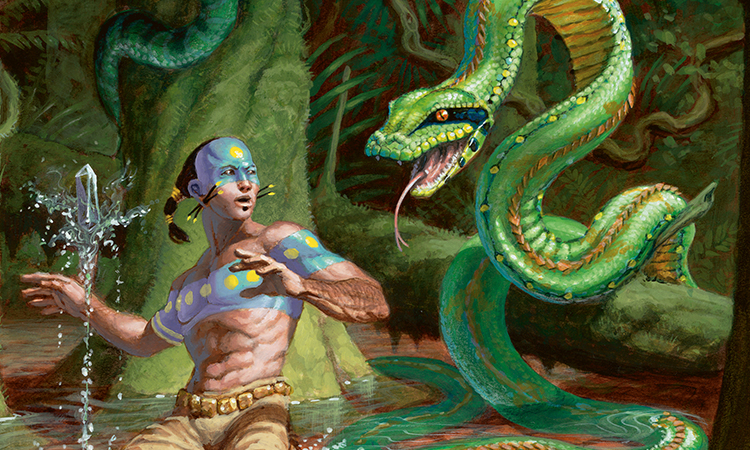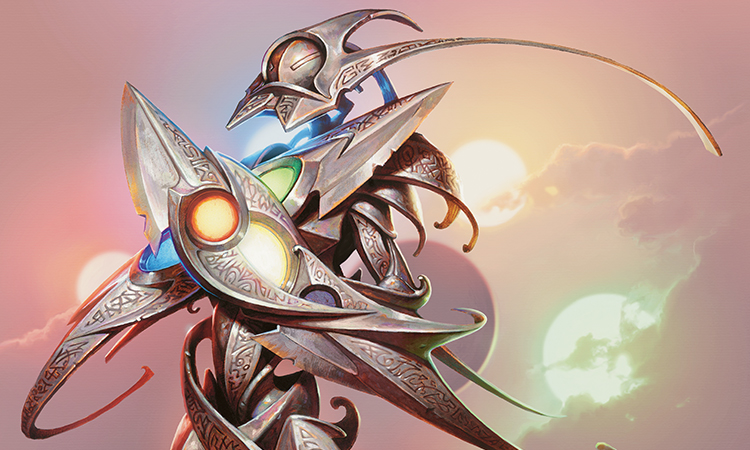Building Your First Cube
Eternal Masters contains some of the most powerful Magic cards of all time, and many of these cards fit perfectly into a Magic cube. Cube is one of my favorite formats to play, and designing your own cube is super fun and rewarding. With the release date of Eternal Masters quickly approaching, now is a great time to build your first cube. Today I'm going to talk about how to build a cube from scratch.
A cube is a large collection of (often powerful) cards used for drafting and playing Limited. Drafting a cube is similar to drafting booster packs, but instead of drafting from three fifteen-card Magic booster packs, you draft from fifteen-card "packs" that you create from your cube.
Building your first cube can be an overwhelming experience. How many cards should it contain? What cards do you choose to put in it? How do you balance colors and create synergy? Often we take for granted the intricate design behind drafting Magic cards. In Booster Draft, the mechanics, synergies, and worlds are already there for us to immerse ourselves in. In Cube Draft, you can also create this experience, and the best part is you get to make all the decisions! The themes, power level, strategy, and rules are all up to you.
Where to Begin?
For your first cube, I recommend using 360 cards. A 360-card cube can support exactly eight players. If you create three fifteen-card booster packs for each player, this means that every single card in your cube will be drafted, which is the most optimal way to experience your cube.
Some cubes contain 720 cards. A 720-card cube can support two eight-player drafts. Many players prefer a larger cube because it allows them to play two eight-player drafts without having to reshuffle, and they'll never see the same card twice. Constructing a larger cube is not necessarily better or more fun. You'll have more draft archetypes and different experiences in each draft, but you'll also have more variance, as you won't see the same cards in each draft. Additionally, 720-card cubes are much more difficult to build and balance, which is why I'll always recommend starting with the 360-card minimum if you've never built a cube before.
Another rule of thumb for building a cube is that you want it to be singleton, or only containing a single copy of each card. A singleton cube is more balanced than a cube that contains many four-ofs. It's no fun for everyone else when one player ends up with all of the copies of Tendrils of Agony and is the only player drafting Storm while the other drafters are fighting over colors and the important four-ofs are split among them. We do want the decks to have little variance, but having many copies of the same card can get degenerate in some cubes. However, Cube is a casual format and there are no clear-cut rules. If your playgroup prefers a non-singleton cube, then you have every right to build it that way!

What Cards Do I Play?
Let's get one thing clear: a cube is not a collection of the most powerful cards in the game. Cubes are fully customizable, and while some players prefer to play the most powerful cards, many players opt to build cubes around their favorite themes and strategies. Ultimately, your cube is your most optimal drafting experience, so if you like to play the most powerful cards in Magic, then by all means go for it! If you instead want to build a cube based around a particular theme or strategy, here are some ideas to get you started.
Worlds and Blocks
One great thing about Magic is that the game contains very deep and unique worlds. They are so deep, in fact, that some have been revisited multiple times. Do you like artifacts? You may enjoy playing a Mirrodin cube, with cards from the six sets associated with the Mirrodin plane. Innistrad is a plane that is adored by many and is known and loved for its great Draft environment. How about an Innistrad cube with cards from Innistrad, Dark Ascension, Avacyn Restored, and Shadows over Innistrad? In fact, during week two of the Community Super League, the players built Innistrad Plane Constructed decks. Here are a bunch of ideas for your cube over on Twitch.
Mechanics and Themes
Maybe you're not interested in Magic lore or worlds. Maybe you want to experience your cube through your favorite aspects of gameplay. There are so many directions for you to take your cube gameplay-wise. Do you like combo? Try out a combo cube with support for decks such as Storm, Dark Depths, Splinter Twin, and Sneak and Show. Like creatures? How about a tribal cube with archetypes for Goblins, Elves, Soldiers, Merfolk, or even some of the more obscure tribes like Cephalids and Dwarves. Maybe you have a smaller collection and would like to build a Pauper cube. Despite being composed of only commons, Pauper cubes are actually quite powerful when you're using the strongest cards from Magic's 23-year history.
How Do I Balance My Cube?
Balancing a cube is difficult, and it will take many play-throughs for you to get it to its ideal state. As sets come out, you'll want to add new cards to your cube—meaning that it's never truly complete. That's one thing that many players enjoy about building a cube; it's a work in progress and a project that is never finished. So how do you actually go about balancing a cube?
Color Balance
The most important aspect of balance is to have the same number of cards per color. Here's a good starting point for your 360-card cube:
- 60 white cards
- 60 blue cards
- 60 black cards
- 60 red cards
- 60 green cards
- 30 nonbasic lands
- 30 colorless artifacts
Here's another template, this time with multicolored cards included.
- 50 white cards
- 50 blue cards
- 50 black cards
- 50 red cards
- 50 green cards
- 50 multicolored cards, with five of each color pair
- 30 nonbasic lands
- 30 colorless artifacts
Artifacts are tricky because some of them either have a colored activation cost or reference a certain color. For example, Vedalken Shackles should be counted as a blue card and Shrine of Burning Rage as a red card. Don't count artifacts as colorless artifacts if they are only for one specific color.

Nonbasic lands are great at helping you get the right colors you need for your deck, but they should be chosen with care. I recommend playing three ten-card cycles, with a land for each color pair. For example, you could play the ten Shadowmoor filter lands, the Ravnica shock lands, and the ten fetch lands. What I'd stay away from are cycles that only provide you with five lands, like the Battle for Zendikar battle lands. Since these lands only provide you with ally color mana fixing, players will be encouraged to draft ally color pairs over enemy ones.
Archetypes
Selecting cards for a 360-card cube is not an easy task, and you may have no idea where to begin. A good starting point is to choose your favorite archetype for each of the ten color pairs and include cards that support those archetypes. Still lost? Here is an example of some popular Cube archetypes for each color pair.
- White-blue—Control
- Blue-black—Reanimator
- Black-red—Disruptive Aggro
- Red-green—Ramp
- Green-white—Midrange
- White-black—Tokens
- Black-green—Sacrifice
- Green-blue—Creatures/Card Advantage/Ramp
- Blue-red—Spells/Combo
- Red-white—Aggro/Burn
While you should include powerful cards to support each archetype, it's also important to include cards that A) are good in any deck and B) work in multiple archetypes. A good example of this is Swords to Plowshares. Swords is a generally strong card that anyone playing white would be happy to draft, and it doesn't fall into a specific archetype. An example of a card that fits into multiple archetypes is Gravecrawler. It's great in an aggressive black deck or a deck that is looking to sacrifice creatures, but it's not so great in Control or Reanimator decks. Having cards like Gravecrawler in your cube will give players a direction to lean in during the draft, but they won't be tied to drafting one strategy.
Including cards that are only for one archetype is fine, but you don't want to include too many of them. For example, many players choose to put the Splinter Twin combo in their cube. Deceiver Exarch and Pestermite are not very powerful on their own; you really need to pair them with Kiki-Jiki, Mirror Breaker or Splinter Twin to make them worth playing. When players select these cards during a draft, they know that they have to draft Blue-Red Splinter Twin. These cards give players a nice direction, but those players will have fewer options than others during the draft.
Playtesting
Playtests are one of the best tools you have to help balance your cube. Each time you draft your cube with eight players, you should be looking for signs of things that are off. Are the aggressive white creatures like Isamaru, Hound of Konda and Eight-and-a-Half-Tails not getting drafted? Maybe white aggro is too weak or you don't have enough cards in your cube to support that archetype. Are five of the eight players playing blue? It's likely that blue is too strong, and you may need to cut some of the efficient counterspells and card draw for spells that are weaker. Does the mono-red player go 3-0 in every draft? Red is likely too strong. These are just a few of the things to look for while playtesting.
Another thing to think about is not really color balance, but rather fairness balance. Are there any cards in your cube that are automatic first picks regardless of a player's color preference? For example, in my personal cube I found that cards like Vedalken Shackles and Treachery were always first-picked no matter what else was in the pack. I also found that I wanted to play more artifact and enchantment removal in my cube to deal with these cards. The consensus was that these cards were un-fun to play against, and it wasn't long before I took them out. Similarly, are there cards that no one ever plays? Maybe there are cards in your cube that are drafted early but never make the final cut in players' decks. These are the cards that should be coming out for different cards.
Wrapping Up
Building and tuning cubes is complex but is also one of the most fun and satisfying ways to play Magic. With Eternal Masters soon to be released, now is the perfect time to obtain powerful, highly sought-after cards and build your first cube. What cards from Eternal Masters are you most excited to play with? Tweet me @MelissaDeTora to start the discussion.
Thanks for reading, and happy cubing!
Melissa DeTora
